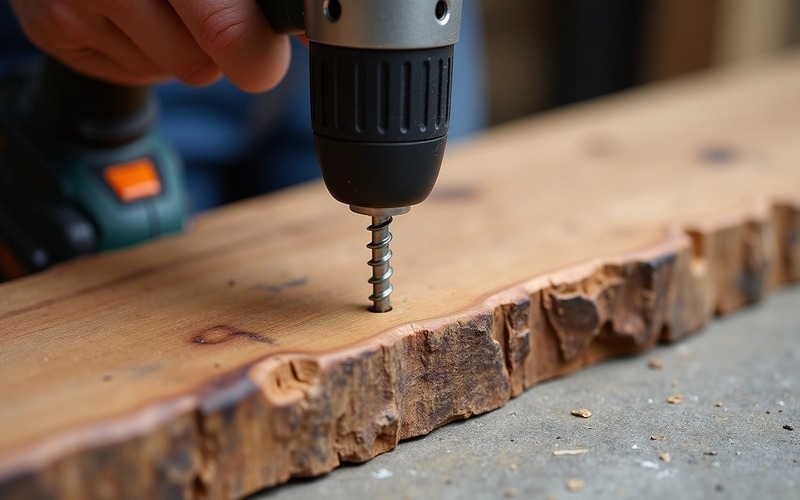
Decking screws hold the boards firmly to the substructure, making the structure stable and strong.
Stripped or broken screws can't provide the necessary holding power required to hold decking boards securely to the joists. As a result, the deck boards may twist or lift, creating an unsightly and dangerous surface to walk on.
If you've never built a deck before or are frustrated by constantly ending up with damaged screws, here's how to ensure that your decking screws will neither strip nor break.
-
Choose the Right Bit Size
The first step in preventing stripped decking screws is to use the appropriate driver bit for the screw.
Drivers come in different sizes. Common Torx sizes are T-20, T-25 and T-30. The Phillips head screws use a #1, #2 or #3 size. Square Drive and Robertson come in #0, #1, #2 and #3 sizes.
Quality fastener manufacturers will clearly state on the packaging what drive is required, and the best such as Eagle Claw Fasteners will include at least one free driver bit.
Furthermore, drivers wear out! Throw worn out drivers away, or keep them for an emergency situation, but always use a fresh driver. This is the only contact point between you and the screw.
-
Align Your Tool Properly
Alignment is crucial when driving decking fasteners. The angle of attack—or how you position your screwdriver or drill—makes a significant difference. To maintain full engagement with the screw head, align your tool perfectly with the screw.
Get your arm and shoulder over the screw, and drive using a combination of bodyweight and shoulder/elbow strength. Misalignment leads to cam-out, which is a common cause of stripped decking screws. Worse still, it can lead to the driver stabbing into and damaging the decking board.
-
Apply the Right Amount of Pressure and Torque
Applying optimal pressure is another key factor in avoiding stripped decking fasteners. Too little force, and your tool will slip out of the screw head, especially as resistance increases. Apply a steady pressure all the way through the drive, following the screw home.
A driver with a torque setting is very handy to ensure a consistent fit and finish. Experiment until you can see the deck board is fixed securely without overtightening.
-
Do you need to pre-drill?
Especially when driving screws into hardwoods, it is always advisable to pre-drill both a clearance hole in the component being fastened, and a pilot hole in the substructure or frame. One old-timer I knew always kept a cake of soap handy to lube the tip of the screw before driving it home!
-
Use Torx Decking Screws
Torx head screws, also known as star head screws, offer several advantages over traditional Phillips or traditional slotted-head screws.
One main benefit of Torx, or star drive, decking screws is their deep socket-like design, which helps transfer torque better and reduces slipping.
The Torx drive's parallel-walled design holds the bit more firmly in the screw head compared to Phillips head screws, which are more likely to strip if insufficient force is applied, allowing the driver to lift even slightly out of the head. This reduces wear on the bit and screw, which greatly lowers the chance of stripping the screw head during installation.
When building or repairing a deck, the goal is to create a safe and strong deck that can last for years. That's why we recommend stainless steel screws with a Torx head.
Since a deck is a long-term investment, choosing stainless steel screws with a Torx head means a hassle-free installation with fewer problems down the line and less need for maintenance.
If you decide on using stainless steel screws for your decking project, make sure you're pre-drilling holes. Stainless steel is softer than carbon steel, so if there's too much resistance, screws can strip, especially in hardwoods. Pre-drilling should match the core diameter of the screw to ensure a tight fit without excessive force.
There are a lot of stainless steel screw providers out there, so make sure you're buying from the store that provides quality decking fasteners for all types of environments.
Remember: Whether you're using softwood, hardwood, or pressure-treated wood, it's important to use the proper screws and techniques, such as drilling pilot holes, and to drive the screws at the correct torque setting to prevent damaging the decking fasteners.
Building The Most Cost-Effective Deck
By preventing the stripping or breaking of your decking screws, you can achieve the deck that every homeowner desires. This ensures that your deck can withstand day-to-day foot traffic without your boards warping, splitting, or, worse, falling apart. Your deck boards will maintain a clean finish without any rust stains, especially if you use stainless steel screws.
But the biggest advantage is how much it cuts down on maintenance costs.
By building your deck with the right screws and techniques, you never have to worry about replacement costs for decades to come.
Last of all, just be thankful for the tools and drive options you have available. Not so long ago, you'd have been trying to drive slotted head screws with a Yankee screwdriver!





